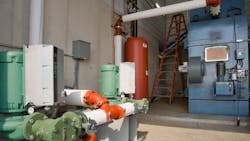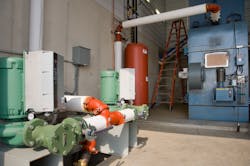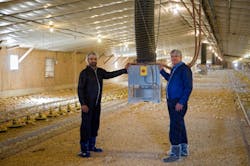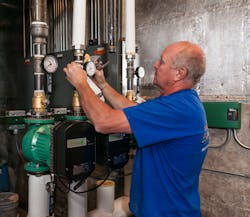Optimizing Commercial Hydronic-System Performance
Just a few years ago, a conversation about optimal hydronic-system performance likely would have veered toward chiller or boiler type and efficiency, building envelope, system design, and/or key components. Today, such detours are not as likely because all parts of systems interact.
“Systems integration is something we’ve worked toward in our industry for decades,” Richard Medairos, PE, senior systems engineer and director of commercial training for Taco Inc., said.
Medairos has been involved in hydronics and commercial-buildings design for more than 30 years, most of them as an independent consulting engineer. What he sees on the horizon is unprecedented energy efficiency, sustainability, ease of operation, and interior comfort.
Medairos credits the merging of system equipment, components, and terminal units; piped networks; high-efficiency, reactive pumps; and building automation systems (BAS) with predictive controls.
One of the latest advancements, Medairos said, has been the expanding reach of sensorless and electronically-commutated-motor (ECM) pumps.
“These pumps—without the need for external sensors—are making it possible to provide the pumping power for large heating and cooling systems with amazing efficiency,” Medairos said.
With sensorless pumping, there is no need for holes in pipes for tubes or taps connecting remote differential sensors to the pump. Additional advantages include greater accuracy for variable flow, higher energy efficiency, lower installation costs, and improved system stability.
Versatility and Control
Most commercial systems track and control pressure differential, or delta-P. Larger systems also may track temperature differential, or delta-T, the difference between supply temperature and return temperature.
“A key benefit is that, if we can control the differential temperature, we can make the primary heating and cooling equipment more energy-efficient,” Medairos said. “For instance, a chilled-water system may operate most efficiently at a delta-T of 12°F. If that system is controlled in the delta-T mode, optimal performance is relatively easy to dial in.”
In the design of hydronic and chilled-water systems, there is a direct relationship between delta-T and flow. The industry adage, “Double the delta-T, and cut the flow in half,” applies. The benefits of increased delta-T stretch beyond a reduced need to burn fuel at the heat source. Reduced flow means being able to use pumps of lesser size and downsize piping, fittings, valves, and other components. The right choices up front can lead to significant savings.
Even with, say, traditional delta-T operation, simple variables can toss a wrench into the works, Medairos said.
“The ideal delta-T for a hot-water baseboard system is 20 degrees,” Medairos said. “But, if a condensing boiler is used, a better delta-T may be 30 degrees or more to assure robust condensation within the boiler.”
However, “Some systems or terminal devices may not operate as effectively with the higher delta-T because of their design limitations or the types of control valves used,” Medairos continued. “That’s where varying flow—by operating with a delta-P mode—may improve overall system performance.
“The challenge when retrofitting equipment instead of designing systems from scratch is that not all current systems were built to operate in a delta-T mode, so it’s best to have pumps and controls that can respond to either method of operation: delta-T or delta-P,” Medairos concluded. “The more versatile the system components, the greater the range control-system designers have, the greater the level of operational efficiency.”
Boldly Go
“To make the primary equipment more efficient, we need to control the delta-T and also to match capacity with the load,” Medairos said. “That’s where variable-speed pumping makes its greatest contribution.”
When there is equilibrium between system capacity and load and optimal delta-T, maximum efficiency is attained. Medairos refers to it as a symbiotic relationship between a system and primary equipment.
“To achieve greatest performance, they need each other in a harmonious fit,” Medairos said. “With new and responsive pump technology, we can now strive for optimal system balance.”
Medairos added: “We need synergy between the central plant—whether it’s a chiller or hot-water system—and the terminal equipment and all parts in between them.”
A key driver is the rapidly growing use of variable-speed pumps. The benefits are substantial:
- Pump speed varies with load. A drop in pump speed will be accompanied by a significant reduction in pump power (at half speed, only one-eighth of the full horsepower is required; at one-third speed, power is reduced to one-twenty-seventh).
- With variable speed, power is increased gradually. Soft starts are beneficial to motors, pumps, and system components.
- Reducing pump speed to match load saves energy and greatly improves equipment longevity.
Cycles are proportional to speed. At half speed, cycles decrease by one-half, substantially reducing wear on components, including bearings, mechanical seals, wear rings, and shaft sleeves.
“So, assuming the pumps perform optimally, system designers can configure systems with precisely prescribed delta-Ts to take exact advantage of all the work a boiler or chiller can do,” Medairos said. “This means lower operating temperatures, higher delta-Ts, and terminal devices with more surface area—something that assures a lifetime of savings.”
The Stage Is Set
With the right BAS in place, all facets of a system are designed to work in unity. Terminal devices with sufficient surface area ensure high delta-T, which translates to healthy advantages at a central plant. Matching variations in system load is an issue of maintaining proper flow.
The final component is a system “barometer,” or diagnostic window, closely tied to the control system allowing operators to observe energy use and savings in real time. An example is a system providing a dynamic graphical interface for remote monitoring of pump and system performance, complete with fully automated BAS integration. Such a system automatically renders graphics showing pump performance, system influences, energy consumption, and energy saved in real time. Additionally, it provides automatic alarming, trending capability, and even predictive-maintenance scheduling.
A key advantage is the ability of the installer, rather than an expensive add-on control or commissioning agent, to see all facets of system performance and, if necessary, balance pump curves easily to fit system resistance. This greatly reduces system-balancing and commissioning time.
For instance, with a chilled-beam system, monitoring supply-air temperature separately via an air-handling unit’s dedicated controller gives system operators predictive control of relative humidity, allowing faster reaction to changes.
“Having to wait for a thermostat to tell you that there’s a comfort issue in a room—or rooms—is simply too late,” Medairos said.
The crusade for total system efficiency is one system designers embarked on decades ago. Although refinements will continue, an important plateau has been reached. The U.S. Department of Energy has assigned ratings for equipment and component efficiency, but not combined system efficiency. Systems experts are moving the industry toward loftier goals, pushing toward what Medairos refers to as “total system integration.”
“The system approach is a bit like holistic medicine,” Medairos said. “Rather than treating a single symptom with no consideration for the whole body, some doctors prefer to treat the whole person, or system—body, mind, and spirit. Similarly, we can now design, rebuild, and rate systems for optimal performance—system health—because we have the means to achieve proper balance and extreme energy efficiency.”
One installation that exemplifies this is Orleans Elementary School in Orleans, Mass. To learn more, read “School Upgrades Hydronic System With Self-Sensing Pumps.”
Case Study: High Technology Down on the Farm
In Lancaster County, Pa., chicken grower Earl Ray Zimmerman operates two 500-ft-long poultry houses, each equipped to organically raise 30,000 broilers from peep to slaughter in five to seven weeks. A lot of chicken feed is required. Of course, what goes in must come out. That meant giant piles of bird waste trucked to fields, a lot of work, and a lot of surface runoff.
Total Energy Solutions LLC, a Willow Street, Pa.-based energy-solutions firm, addressed Zimmerman’s heating and manure-disposal needs. Today, Zimmerman’s two poultry houses are heated with a state-of-the-art biofuel hydronic system.
Matthew J. Aungst, co-owner of Total Energy Solutions, teamed with Taco to provide the engineering brainpower to get energy where it needs to be using KV series sensorless pumps.
Depending on conditions, one poultry house can call for up to 600 MBH at any time, though a typical winter heat load is 200 to 300 MBH per house.
Every six weeks, chicken manure is removed for storage and drying before being fed by auger into a 1.5-million-Btu biofuel boiler.
In the mechanical building, two redundant pumps and their variable-frequency-drive (VFD) counterparts sit side by side, plumbed in parallel. Above, a suspended Taco 4903 air and dirt separator keeps the water lines clean and quiet. A 125-gal. Taco expansion tank smooths out the loop.
Three-inch, pre-insulated cross-linked polyethylene water lines disappear underground through the concrete floor to a distribution manifold between the poultry houses.
Taco SKV3009 self-sensing pumps include a motor-mounted VFD to deliver precise flow and pressure. The pumps accurately respond to changes in system demand with no need for pressure sensors. If a main supply valve to one of the poultry houses is closed, the pumps sense the change and ramp down according to lower demand. Seconds later, the pressure gauge drops on the supply side.
Inside each poultry house, eight unit heaters hang from the ceiling, providing water-to-air heat exchange. Automatically, the pumps react to the call for waterborne heat.
“A specific program enables the pumps to ‘know’ exactly what speed to run at any given time,” Aungst said. “You get tremendous energy savings this way.”
During design, Aungst calculated a delta-T of 25°F.
Each of the 7.5-hp pumps is programmed to supply a maximum of 125 gpm at 85 ft of head. According to Jeff Pitcairn, Taco’s commercial regional manager, Pump A runs as “duty,” leaving Pump B for backup. After several days of run time, the pumps automatically switch roles.
Case Study: Rocky Mountain Hydronics
Sierra Grande School in Fort Garland, Colo., struggled to make it through a recent winter. Three 1.8-million-Btu liquefied-petroleum-fired cast-iron boilers provided water at 160°F to a variety of fan-coil units. One of those boilers had been down for some time, while another caught fire midway through the heating season. The third heated the building minimally until spring break. Meanwhile, a long-outdated pneumatic control system negated the possibility of individual classroom control.
After years of deliberation, the school board decided the 80,000-sq-ft, 42-classroom K-12 school would receive a new system.
“We removed and replaced 4.8 million Btus worth of boiler capacity,” Matt Husmann, president of Alamosa, Colo.-based Husmann Plumbing and Heating, said.
Mike Merryman of Littleton, Colo.-based manufacturers’ representative McCoy Sales (now Motion & Flow Control Products) assured school officials that, with a hydronic overhaul that included boilers, electronically-commutated-motor (ECM) pumps, and various changes to the pumping and piping arrangement, 50- to 65-percent energy savings would be realized.
Six 800-MBH modulating condensing boilers tied to outdoor reset were installed, and the old pneumatic controls were replaced.
Husmann specified six variable-speed, ECM, wet-rotor Taco Viridian pumps, one for each of the zones branching off from the large secondary loop. The pumps were chosen mainly for their ability to ramp up and down, matching the needed flow rate, regardless of the number of classrooms calling for heat.
The pumps offer an 80-percent decrease in energy consumption compared with a standard pump of the same size. With built-in Web-based access and capacities of up to 375 gpm, the Viridian line meets a wide range of closed-loop applications.
Four to 10 classrooms are tied into each secondary loop. Each classroom terminal unit was fitted with new electronic zone valves.
The pumps speed up and slow down according to pressure differential (the number of zones that are open), turn on and off in response to thermostats, and can be controlled from an external building management system.
The new hydronic system far exceeded the school’s expectations in terms of comfort, performance, and efficiency.
Superintendent Darren Edgar said the school previously used 28,600 gal. of propane. In the three winters since the system was overhauled, it has used considerably less, and the new equipment has performed flawlessly.
The president of trade-communications firm Common Ground, John Vastyan is a journalist who has been writing about the plumbing-and-mechanical and HVAC industries for 25 years. He can be reached at 717-664-0535.
Did you find this article useful? Send comments and suggestions to Executive Editor Scott Arnold at [email protected].



